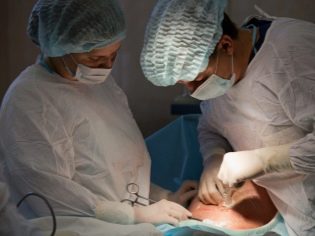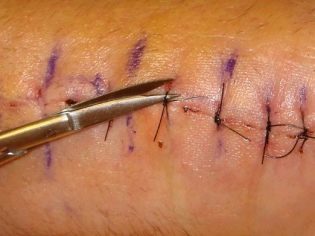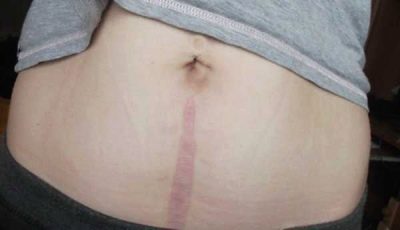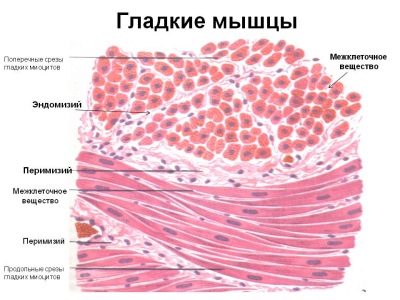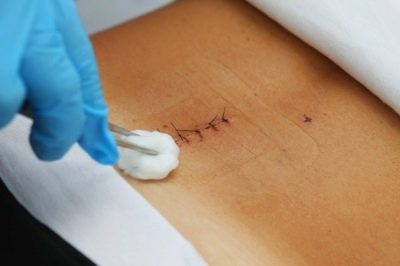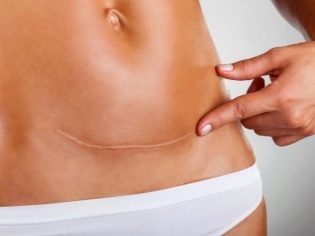How many days does a suture usually heal after a cesarean section?
After cesarean section, sutures are an unpleasant and inevitable consequence of surgical delivery. They do not always look aesthetically pleasing, moreover, they do not always heal without problems and complications. In this article we will tell how long the healing of postoperative sutures lasts.
Kinds
The mechanisms of healing of postoperative sutures left after the performed cesarean section depend on the type of sutures, the technique of their execution and the surgical suture material used.
Since not only the abdominal wall but also the anterior uterine wall is subject to dissection during surgery, the stitches after obstetric surgery are divided into two main types:
- internal;
- external.
Internal sutures are placed on the dissected wall of the uterus immediately after the uterus is free from the baby, the amniotic sac and the placenta. For their application, surgeons usually use single-row continuous suturing and a special type of suture material - threads that do not need to be removed and processed later, as they dissolve themselves as the edges of the wound grow together.
Outer seams are mostly carried out by the nodular or stitch method. For them, they use either special medical silk threads, or self-absorbable threads, but thicker than internal ones, or staples from a special medical alloy that does not oxidize.
Depending on how exactly the surgeon performed the caesarean section, the type of suture depends. If a planned operation was done, during which no abnormal situations arose, then the incision usually does not exceed 10 centimeters in length, it is located horizontally above the pubic line. This cut is called a Pfannenstiel dissection. It heals faster and with fewer complications, since the place chosen for penetration into the abdominal cavity is least subject to skin stretching and other external influences.
If the operation had to be done for urgent vital reasons on an emergency basis, then it is possible that the incision will be made vertically - through the navel line to the middle of the pubic zone. This is necessary to quickly remove the baby who is threatened with death. They call this seam corpulent, it crosses the rectus abdominis muscle, and therefore heals longer and worse.
Horizontal low seam in most maternity hospitals today make cosmetic. It is almost invisible after complete healing and is easily masked by the elastic of the underpants. Vertical seam can not be neat and hide it will be difficult.
How is the healing process?
The healing process of different types of postoperative sutures is different.
The inner scar is formed longer than the outer one, and it is quite understandable if you know what kind of jewelry and painstaking work takes place in the body after suturing the uterus. In the first 24 hours, the edges of the inner wound made with a scalpel stick together due to fibrin filaments, with each hour their bonding becomes more and more durable.
6-7 days after the operation, new cells are formed in the rumen on the wall of the uterus - myocytes, which are structural cells of the uterine tissue. Collagen begins to be produced, giving elasticity to the surgical suturing area.When these fine processes are disturbed, more coarse connective tissue is formed, due to which the scar becomes insolvent. Then it can be a serious complication of subsequent pregnancy and childbirth.
In total, the initial formation of the internal scar takes about 2 months. Then the process of its development continues, and after 2 years, the scar, if it is completely consistent, is considered sufficiently strong and reliable for carrying the next pregnancy.
Outer sutures heal faster. The stitches on the vertical corporal scar can heal up to 50-60 days, the probability of complications is higher than with a small horizontal dissection in the very lower abdomen. The seam after the Pfannenstiel section can be removed already on the 7th day, and it takes about three weeks to complete the healing of the surgical area. The external suture heals completely and becomes lighter and less noticeable about a year after surgical delivery.
Why bad heals?
Often women are faced with the fact that the stitches heal slowly, poorly, there are certain complications. According to the time of onset of symptoms, there are early and late complications.
By early include a variety of options for infectious inflammatory processes. A caesarean section always carries the risk of attaching an infection, and there’s no way around it. Our world is inhabited by bacteria, viruses, fungi, some of them can survive even in a clean operating room.
Any inflammatory process will be manifested by pain, the discharge of ichor from the scar, possibly even pus. Also, most often the woman fever and there is pain in the area of the scar.
Excessive bleeding of the scar after surgery may indicate injury to the vascular node at the time of suturing. This can happen even with an experienced surgeon. This complication is characterized not only by secretions from the suture of the bloody plan, but also by the formation of hematomas around the scar and on it.
Less common is the overlap of the seam. This can happen because of the increased motor activity of a woman at first, due to carelessness, due to the immune rejection of the suture material by the female body.
Discrepancies of the internal suture usually proceed without any special symptoms, and only when the uterus disperses, weakness appears, can there be bleeding, loss of consciousness, drop in blood pressure, tachycardia. The causes of internal complications are the same as in external ones.
Non-healing of the scar can fully lead to late complications - for example, to the formation of a hernia or to the appearance of a ligature fistula.
Useful Care Tips
The seams on the uterus are not treated. But a woman can quite protect them if she does not lift weights, does not start having sex too early, and prevents any infection from entering the genital tract, even with tap water when performing hygienic procedures. In order to avoid infection, in the early period of rehabilitation in the maternity hospital, it is recommended to use not purchased sanitary pads, but exclusively sterile hospital bed sheets. They are changed every 3 hours.
At home after discharge, a woman can use sanitary pads, but it is advisable to change them every 2 hours in the first week and less often afterwards.
External seams need care and processing. At the maternity hospital, the medical staff is involved in this, but after discharge, this will have to be done at home. Every day it is recommended to dry the scar with hydrogen peroxide, process the edges with green paint, and continue to wear a surgical dressing until the sutures are removed. After removing the stitches recommendations may be individualized. If he heals quickly and well, the bandage is recommended to be removed. If there are problems, it is recommended to continue processing and wearing a gauze bandage.
The healed outer seam cannot disperse, which cannot be said about the inner one.A scar on the uterus, if it is not wealthy, can be separated during subsequent pregnancy, and during repeated births. To prevent this, a woman should be aware of the prevention of complications from scarring:
- Conduct a treatment regularly, if you detect any abnormalities, contact your doctor immediately;
- sex after surgery is allowed after cleaning the uterus from lochia - the discharge should stop, but not earlier than 2 months after the operation;
- tampons in everyday hygiene can not be used;
- avoid douching;
- the subsequent pregnancy should not come too early, the recommended break is at least 2 years;
- do not squat, do not jump, do not swing the press, if half a year has not passed from the day of the operation.
To heal the scar looked more aesthetic, after its healing is allowed to use the tool "Contractubex", It reduces scars and scars and makes them less distinguishable. But the remedy is effective only for “young” scars that have not yet turned a year. Then, to eliminate the ugly scar will have to use other methods - laser grinding, injection correction, surgical excision of the ugly scar and the formation of a new one. Each method has its pros and cons.
In practice, it is rarely necessary to resort to correction, since cosmetic stitches, which they try to impose in a special way while still in the maternity hospital, do not deliver large problems to their owners at the healing stage.
Some details of the care of postoperative suture after cesarean section are given in the following video.


